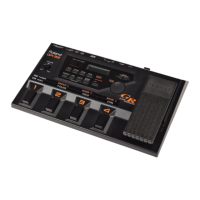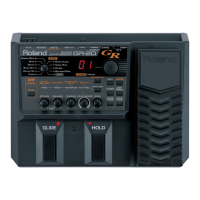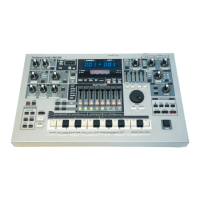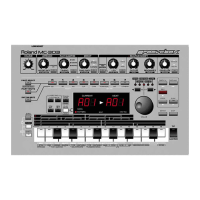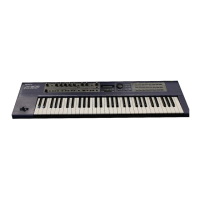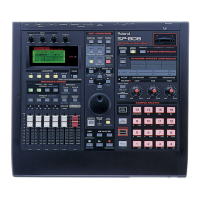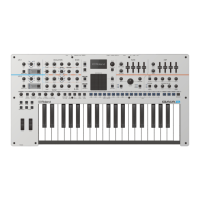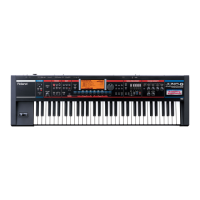Adding Synth Sounds to
Guitar Sounds
The commercially available effecter known as
“Harmonist” is a type of pitch shifter, and can make
harmonies for guitar sounds only with guitar sounds.
In contrast to this, the GR-30 Synth Harmonist lets
you take the guitar sounds you normally use and
make harmonies with any sounds you like.
These can be put to practical use, such as by adding a
marimba harmony to a clean guitar sound to produce
an understated harmony, or adding a rock organ to a
distortion guitar to create a minor-key harmony.
And of course, you can always select a guitar tone on
the GR-30 to create pure guitar harmonies.
If you wish to create a harmony with a guitar sound
and the GR-30’s sound, set the guitar/synth selector
switch on the GK-2A to “MIX.”
✽
To make all synth sounds selected with patches (from
both the first and second tones to the external MIDI
sound generator) a harmony part in combination with
the guitar sound, follow the steps of p. 66 to set
“ARPEGGIO/harmony SEL” to “hAr.”
Creating Harmonies with
Two Synth Sounds
You can make harmonies using only synth sounds
and without playing the guitar by setting the
guitar/synth selector switch on the GK-2A to
“SYNTH.”
Let’s call up patch E12, for which Harmonist is on. In
this example, the first tone (distortion guitar + bass
guitar) is the main melodic line, and the second tone
(distortion guitar with feedback) is the harmony.
Play a melody in C major and hear the “fat” guitar
orchestration composed exclusively of synthesizer
sounds.
Also, patch F42 is an example of using Harmonist to
create character for an instrument, and realistically
reproduces the ambience of an accordion. This patch
produces the same C-major third harmony as E12
above, but the disparate sounds make for a complete-
ly different effect.
These examples use fairly similar sounds to create the
harmonies, but it can also be quite effective to create
harmonies with totally different tones (such as sax
and muted trumpet), and use COMMON “PAN” (p.
39) to assign these to the left and right stereo posi-
tions. Naturally, you can also combine guitar sounds
to the main melodic line by setting the switch on the
GK-2A to “MIX.”
65
9
What You Can Do with the Harmonist
Operation
Turning the Harmonist On and Off
During a performance, you can toggle Harmonist on
and off by pressing pedal 4 (ARP/HAR CTRL) while
in the Pedal Effect mode (or when PATCH INC/DEC
BY S1/S2 has been selected while in the Play mode).
You can also switch Harmonist on and off in the same
way when the EDIT TARGET dial has been set to
“ARPEGGIO/harmony” while in the Edit mode.
Each patch has a setting that determines whether
Harmonist is on or off.
In the Edit mode, you can save the present state (on or
off) by setting the PARAMETER SELECT dial to
“WRITE PATCH?” and pressing [+] and [-] at the
same time. This state is then enabled the next time
you call up the patch.
(For many preset patches, Arpeggiator is selected
instead of Harmonist. To use Harmonist with a patch
for which Arpeggiator is selected, follow the steps in
the next section to set “ARPEGGIO/harmony SEL” to
“h-2” or the like.)
When Harmonist is turned on, “ARP/HAR” on the
five-point indicator lights up red. (Green indicates
Arpeggiator.)
✽
If you try to change related value or setting (“(ARPEG-
GIO/) harmony SEL,” “h-style,” “h-key,” or “h-
remote”) for a patch with Harmonist off, Harmonist is
turned on automatically to let you check the effect.

